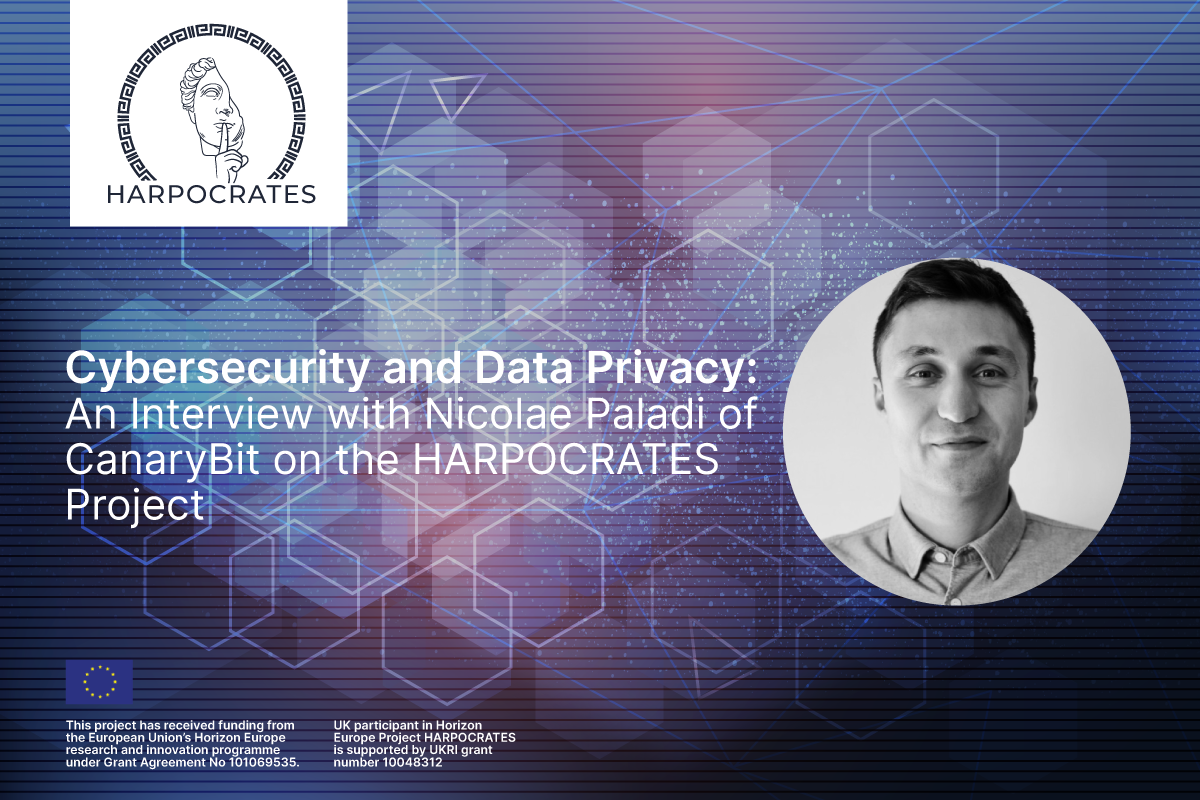Cybersecurity and Data Privacy: An Interview with Nicolae Paladi of CanaryBit on the HARPOCRATES Project
26.9.2023 13:37

- Briefly Present yourself and your organization and role in the project.
I am the CEO and co-founder of CanaryBit. I also represent the CanaryBit team within Harpocrates and lead WP3 on platform architecture. I have worked in cybersecurity for 12 years – starting from distributed systems security, to cryptography and most recently to security of AI systems.
- As the project is ongoing, what are your current thoughts on the progress of the HARPOCRATES project?
I think the project started off well and has kept a good dynamic since then. We already identified some road blocks early on and worked around them.
- Could you provide an update on the objectives and milestones achieved so far in HARPOCRATES?
There’s plenty to unpack! We have defined an early version of the HARPOCRATES Architecture and have a good understanding of how the components will be working together. Most importantly, we managed to define the scope of the use case demonstrators and even run some experiments on data provided from use case partners.
- From a technical perspective, what are the potential benefits that HARPOCRATES can bring to the field of cybersecurity and cloud-based services?
HARPOCRATES realises the vision of end-to-end data protection, where data owners keep control of their data throughout the processing lifecycle: when data is collected, transferred or processed. Now, you control how others process your data and who gets the results, which is a major paradigm shift when it comes to cybersecurity in general and cloud-based services in particular.
- Why is the research and development of HARPOCRATES important in addressing existing challenges in the industry?
As digitalization proliferates through all aspects of the society, limitations to data sharing seriously hamper societal development and economic growth. Data sharing is limited because of many considerations – privacy concerns, business competition, regulations, and many more. However, at the root of this is the concern about data security. Once this is addressed, we will see a massive growth of the data economy.
- Do you feel that resource expensive encryption techniques that HARPOCRATES develop, such as the one based on fully homomorphic encryption will find its way soon into industry application?
Since the start of HARPOCRATES I have gradually shifted my position on cryptographic computation techniques such as homomorphic encryption. Earlier on I was looking forward to significant progress where arbitrary data can be processed using fully homomorphic encryption. Now I got a more nuanced understanding of this: I think that the security community needs to focus on leveraging the toolbox of complementary solutions to improve the state of security instead of pursuing a “holy grail” which remains a moving target. However, I admit that this pursuit is fun in itself.
- What can you tell us about the overall technical enablers of HARPOCRATES, including its main components, mechanisms, algorithms, and models?
The HARPOCRATES platform will be a combination of containerized cryptographic enablers; in some use cases they will be deployed on CanaryBit’s proprietary Confidential Cloud platform, in order to combine the privacy, confidentiality and integrity properties of the components developed in the project and the underlying platform.
- Do you foresee HARPOCRATES to be the next popular open source cyber security project? Why?
I think individual components developed within HARPOCRATES can become popular open source tools or be contributed to interested open source communities. The exploitation plans of some consortium partners mention open source strategies, but running a large-scale open source project is a challenge in itself. I certainly do hope that HARPOCRATES will provide tangible open-source contributions.
- What are the key outcomes of the project that your organization will provide?
Throughout HARPOCRATES CanaryBit continues to develop its Confidential Cloud platform which is contributed as background to the project. Moreover we are working on a privacy-preserving extension for the Flower Federated Learning framework, which uses Homomorphic Encryption to perform secure parameter aggregation. Moreover, CanaryBit actively contributes to standardization in the Internet Engineering Task Force (IETF), Confidential Computing Consortium (CCC) and the Cloud Security Alliance (CSA).
- In your opinion, what potential impact do the results of HARPOCRATES have on the cybersecurity and cloud-based services market?
It is too early to say since the project still has two years ahead of it. However, it is already clear that HARPOCRATES will contribute a more nuanced understanding of the applications and limitations of homomorphic encryption and functional encryption. Moreover, CanaryBit already achieved good results in privacy-preserving data sharing of cyber threat intelligence using federated learning with secure aggregation deployed in a confidential computing environment. We have two more years to run more extensive tests involving more partners and bring that to a higher TRL (or directly to the market).
Closing words
HARPOCRATES is a very ambitious project and we have already achieved a lot in the first year. What I particularly like is the diversity of partners and approaches. The project includes partners doing fundamental cryptographic research and implementation, and those applying it to solve concrete use cases and challenges in cybersecurity and healthcare research.
